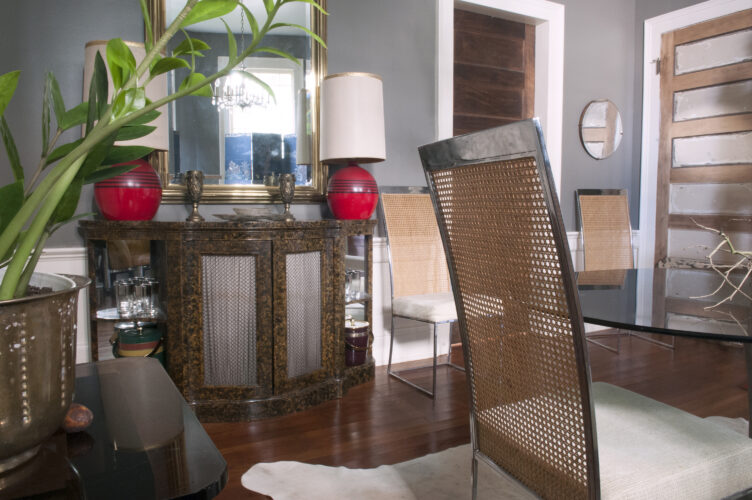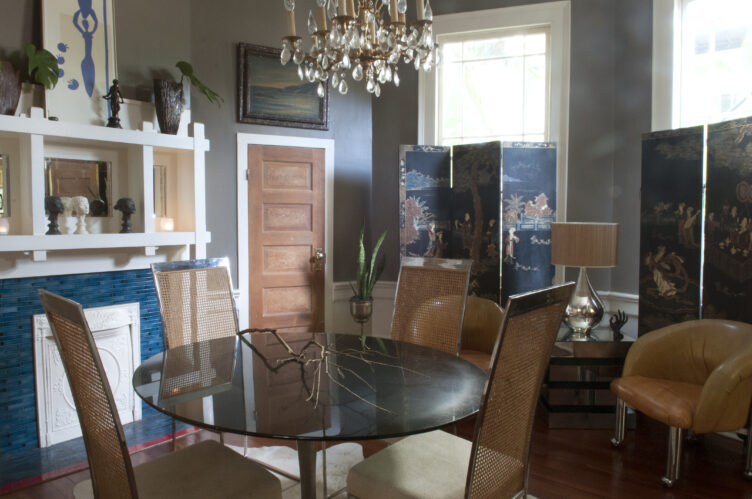Founded by artist and musician Carly Sioux, NO ERA has a unique take on presenting the world of vintage. In almost Cindy Sherman-esque portraits, Sioux develops theatrically staged, Super-8 style product reels that incorporate her vintage products to draw attention to the drama behind their designs. She’s able to blur the creative lines of different eras and transcend our pre-conceived ideas of certain periods or styles to create a unique, high-design new way of looking at the classics.
We spoke with Sioux about how she launched her company as an artist, how New Orleans lends an indelible flavor to her brand, and how she likes to mix eras seamlessly—and sometimes unexpectedly. See what she had to say below and be sure to shop NO ERA’s one-of-a-kind offering right here on Chairish.

Firstly, how did NO ERA get its start? How did you select the name, and what does it mean?
NO ERA was an epiphany realized over a morning cup of coffee in bed. It has always been a ritual of mine to pull tarot cards and journal on Saturday mornings. One particular session, the words “NO ERA” came to mind, and I thought to myself, “this is brilliant.” At that time I was still freelancing as a stager and visual merchandiser for a couple of antique showrooms in New Orleans, which gave me direct access to some of the most eclectic, unusual, and stately furnishings in the area. Seeing this as an opportunity, I began to slowly build my collection.
The name NO ERA essentially means timelessness. As a design concept it has allowed me to collect objects and furnishings as I please without being constrained to any one or two stylistic periods. It’s easy to put together a room of mid-century modern, but not many people can achieve this high-contrast style of juxtaposing different eras in a cohesive, intentional way.

You have a very different type of presentation for your products, incorporating theatrical photography and a sense of drama to display them. Tell us a bit about that.
My background is in the arts and I’ve always identified more as an artist than a traditional designer. My work as a conceptual artist and musician have greatly influenced my work in NO ERA. I’ve created several experimental self portraiture films over the years that are very much inspired by the surrealist shorts of Maya Deren and Kenneth Anger. Naturally, that cinematic style has crossed over into No Era’s marketing materials. I have found that Instagram reels are the perfect platform to feature these film noir shorts both for my personal work as well as NO ERA. I recently learned that Mario Bellini was one of the first provocateurs to push edgy, scandalous marketing campaigns for B&B Italia in the 1970s, as well as Ray and Charles Eames, who made hundreds of experimental videos of their designs and concepts. What I’m doing is not new but being rediscovered, just like vintage furniture.

You talk a lot about sustainability, as well. What role does that play in your love of vintage and in the way you run your business?
Sustainability is a big buzzword right now, but it goes beyond selling used furniture and repurposing packaging material and calling oneself sustainable. I try to be conscious of the whole ecosystem within my industry and local community. I never low-ball my vendors, dealers, or labor. I am always fair in my negotiations and find that the more generous you are with others, the more that generosity returns to you. For instance, I have a few dealers who always reach out to me to give me first dibs on their latest finds. Be kind to your local economy, pay people what they are worth, and invest in your relationships. I’m also doing more short-term rental design in New Orleans, which is a delicate topic here. Most locals are anti-Airbnb so I push for my clients to source as locally as possible, as it puts money back into our economy. It’s a way for these property owners to pay back the communities they are profiting from. It might not be the full solution, but I’ve received a lot of enthusiasm from the local community.

You launched the business in 2019, right before the pandemic. How did that affect the business, and how did you manage your sourcing?
The pandemic economy was actually really great for NO ERA. Big risks were taken and the focus was on expansion rather than retraction. Everyone was freaking out and selling off all of their furniture, and it was crazy cheap at that time. I started buying everything and relocated into a 2,400-square-foot short-term rental in The Treme and started filling it with furniture.
You’re based in New Orleans, which is an incredibly special place with its own sense of design. How does that come out in NO ERA?
The name NO ERA is actually a nod to my adopted city of New Orleans. There is so much incredible and historically significant architecture down here. This city is full of gorgeous French antiques and a lot of emphasis to preserve and uphold its historical integrity. Juxtaposed within all of this Old World charm, there are several world-class hotel bars and restaurants like Saint Vincent, The Chloe, Bar Marilou, The Elysian, and The Columns hotel, who effortlessly blend those sumptuous, regal, and decadent elements of New Orleans design but with a fresh and contemporary approach. These spaces still pays homage to the opulence and tradition of New Orleans living while remaining current and relevant on an international scale. I find a lot of inspiration in these places. I’ve always affectionately referred to my personal style as Regency Goth, which borrows from the hallmarks of Hollywood Regency, Chinoiserie, Art Deco, late mid-century modern, and Bauhaus. Only in New Orleans would a thing like Regency Goth exist and thrive.

What types of pieces do you see moving these days? What are the patterns in terms of what’s selling right now?
Ever since the Gucci movie, I am seeing a huge trend of 1970s and 1980s Italian furniture, which has always been the cornerstone for NO ERA. That means lots of mirrored, smokey glass, brass and lacquered furniture, as well as biomorphic sculptures and statement lighting.
What’s a dream piece you’d love to own yourself?
I am obsessed with Willy Rizzo and would love to own one of his iconic mirrored swivel coffee tables. I am also super into lounging and comfort and would love to own a real, vintage Camaleonda sofa by Mario Bellini.
Do you see any upcoming trends in terms of what’s next for the design world? What types of pieces do you hope to stock next?
It seems with the prevalence of social media, online influencers, and the accessibility of inspiration, that fashion and design trends have collapsed on top of themselves. The 1970s, 80’s, 90’s and now the cringy Y2K era are all relevant at this moment in the dialog on design. On a local level, I’m seeing a lot of sellers here embracing Grandmillennial. As I mentioned earlier, the more sophisticated, European high-end furnishings of the 1970s are very desirable right now. We’re also starting to see a decline of mid-century moderns as it is transitioning into Art Deco classics. As for what I collect, mirrored everything, burled wood, smokey glass, Crespi-style rattan, chrome and brass furniture, and statement lighting.

Are there any styles or trends you’d like to see disappear in the design world right now?
I really hope we’re done with the Jungalow-Boho look for a while. There is also a lot of bad 80’s furniture that’s been trending for some time now. Some of these pieces folks are pushing just look so harsh and heavy. This is the “Made in China” era and there is a lot of bad quality and I think a lot of those pieces are going to get tired really fast. Mid-century might wane in popularity, but those pieces will always be classics because they are so artfully designed.
Who are some of your favorite makers or designers, in terms of your own inspirations?
Kelly Wearstler is particularly entertaining to watch. She is the queen of neutrals and her interiors are fresh and elevated. I also enjoy seeing a mature woman portrayed in this sexy, high-fashion role that is often reserved for much younger women. I am so here for this!
Lead image: Mark Mascar








































